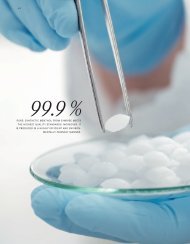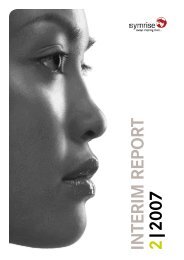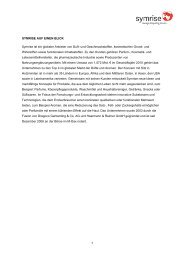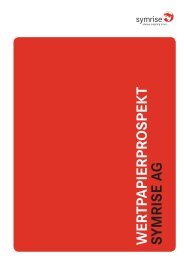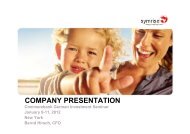THE NATURE OF OUR BUSINESS – STABLE GROWTH - Symrise
THE NATURE OF OUR BUSINESS – STABLE GROWTH - Symrise
THE NATURE OF OUR BUSINESS – STABLE GROWTH - Symrise
Create successful ePaper yourself
Turn your PDF publications into a flip-book with our unique Google optimized e-Paper software.
opment costs recognized are amortized over the period of<br />
expected future sales revenues connected to the related project.<br />
The carrying amount of the development costs is reviewed annually<br />
for impairment if the asset is not yet in use or more frequently<br />
if indications of impairment arise during the course of the year.<br />
Inventories<br />
Inventories are valued at the lower of cost and net realizable value.<br />
The cost of inventories includes the cost of acquiring the inventories,<br />
production or conversion costs, and other costs incurred to<br />
bring the inventories to their existing location and condition.<br />
Net realizable value is determined as the estimated selling cost<br />
less the estimated costs of completion and any necessary selling<br />
expenses.<br />
Raw materials are valued using the weighted average purchase<br />
cost.<br />
Finished goods and work in process are valued with the cost of direct<br />
materials, direct labor as well as other direct costs and a reasonable<br />
proportion of manufacturing overheads, based on normal<br />
capacity utilization, excluding borrowing costs.<br />
Trade and Other Receivables<br />
Trade receivables are recognized at their original invoice amounts<br />
less an allowance for uncollectible receivables. An allowance is<br />
made when there is substantial objective evidence that the Group<br />
will not be able to collect the receivables. Receivables are derecognized<br />
as soon as they become uncollectible.<br />
Impairment<br />
Financial assets<br />
Financial assets are measured at each reporting date to determine<br />
whether there is any objective evidence of impairment. An impairment<br />
loss is recorded if objective evidence exists that one or<br />
more events have had an impact on the future cash flows deriving<br />
from the asset.<br />
An impairment loss with respect to a financial asset measured at<br />
amortized cost is determined as the difference between its carrying<br />
amount and the present value of the estimated future cash<br />
flows, discounted at the original effective interest rate. An impairment<br />
loss with respect to a financial asset held as available-forsale<br />
is determined by reference to its fair value.<br />
Annual Report 2008 <strong>Symrise</strong> AG 109<br />
Individually significant financial assets are tested for impairment on<br />
an individual basis. All other financial assets are collectively assessed<br />
in groups that share similar default risk characteristics.<br />
All impairment losses are recognized in the income statement. Any<br />
cumulative losses with respect to an available-for-sale financial<br />
asset previously recognized in equity are transferred to the income<br />
statement.<br />
Assets recognized at amortized cost<br />
If objective evidence exists that loans and receivables accounted<br />
for at amortized cost are impaired, then the amount of the loss is<br />
determined as the difference between the carrying amount of the<br />
asset and the present value of the estimated future cash flows deriving<br />
from the asset, discounted at the original effective interest<br />
rate. The carrying amount is either reduced directly or indirectly<br />
using an allowance account. The amount of the loss is recognized<br />
in profit or loss.<br />
The Group first of all assesses whether objective evidence of impairment<br />
exists for financial assets that are individually significant<br />
and also assesses, for assets which are not individually significant,<br />
whether such evidence exists that these are individually or collectively<br />
impaired. If the Group determines that there is no objective<br />
evidence of impairment of an asset, whether the asset is individually<br />
significant or not, it includes the asset in a group of financial<br />
assets with similar default risk characteristics and collectively assesses<br />
them for impairment. Assets that are individually assessed<br />
for impairment and for which a new impairment loss is recognized,<br />
or for which an impairment loss continues to be recognized, are<br />
not included in any collective assessment of impairment.<br />
If the amount of the impairment loss decreases in a subsequent reporting<br />
period and the decrease can be objectively related to an<br />
event that occurred after the impairment loss was recognized, then<br />
the previously recognized impairment loss is reversed. The subsequent<br />
reversal of the impairment loss is recognized in profit or<br />
loss to the extent that the carrying amount of the asset does not<br />
exceed its amortized cost at the date of reversal.<br />
Non-financial assets<br />
At each reporting date, the Group assesses whether evidence exists<br />
that an asset is impaired. The carrying amount of items of<br />
property, plant and equipment is reviewed for impairment when<br />
events or changes in circumstances indicate that the carrying<br />
amount of the asset is not recoverable. If any such indications<br />
exist, or if an impairment test for the asset is required, then the<br />
Group estimates the recoverable amount for the asset. An asset’s<br />
Notes



